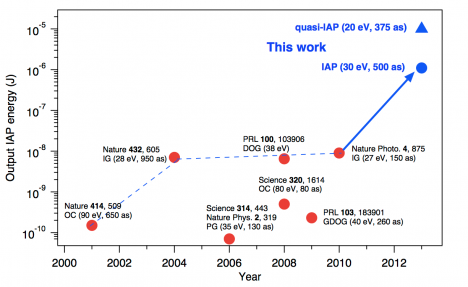The work of CUI-scientist Oliver D. Mücke and colleagues, which has just been published in Nature Communications, opens up exciting new possibilities for nonlinear attosecond science: Isolated attosecond pulses in the extreme ultraviolet (XUV) obtained from a nonlinear process called high-harmonic generation (HHG) in gases are a unique tool to observe the fastest electronic dynamics in atoms, molecules and solids. So far, the very low efficiency of the HHG process has permitted the generation of only weak isolated attosecond pulses, that are not strong enough to realize attosecond slow-motion cameras based on the XUV-pump/XUV-probe technique, which can be used, for example at large-scale facilities such as XUV free-electron lasers. Consequently, attosecond spectroscopy so far has relied on cross-correlation methods, that combine the weak isolated attosecond XUV pulses with the much stronger laser pulses that produce them.

Progress of the energy of isolated attosecond pulses (IAPs) used in attoscience experiments. Red circles: previous milestone results using various schemes, blue points: this work. Note the dramatic leap in IAP energy by two orders of magnitude achieved in this work
Eiji J. Takahashi and coworkers from RIKEN (near Tokyo) and CFEL now proposed and demonstrated a robust generation method of intense isolated attosecond pulses, which enabled them to perform a nonlinear attosecond optics experiment in nitrogen molecules. In a carefully designed HHG experiment using two-color driver waveforms and an energy-scaling method of HHG, they obtained isolated 500-attosecond-short pulses at 30 eV photon energy with a record pulse energy of up to 1.3 μJ, thus demonstrating a >100-fold pulse-energy increase compared with previous reports. The peak power of this tabletop light source reaches 2.6 GW, which even surpasses that of an XUV free-electron laser.

